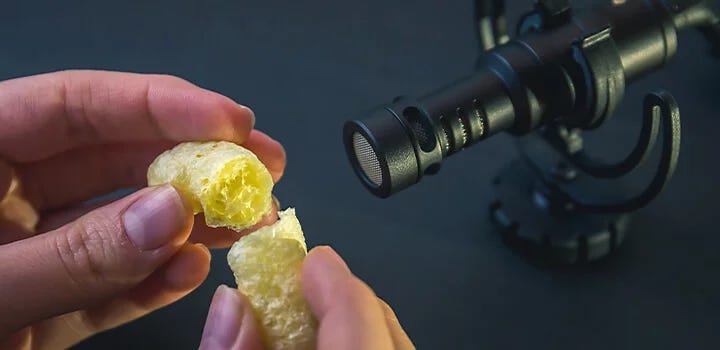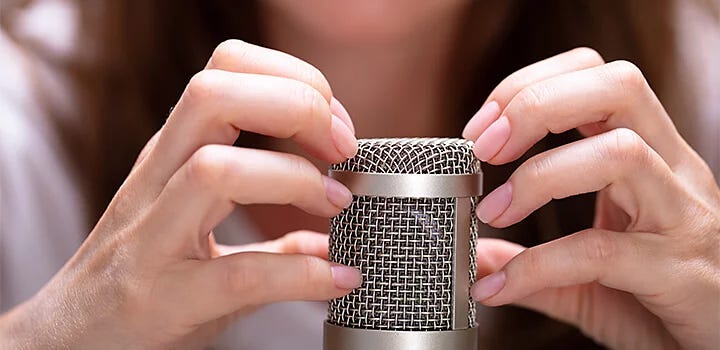Could ASMR Be a Brand's Secret Weapon?
ASMR is a budding yet eerie phenomenon - can low whispers and crinkled wrappers mold into an actual marketing strategy?
Certain sounds in the world are universally soothing.
The thunder of a waterfall. The crashing of waves. The crackling of a fire.
We don’t second guess nature sounds or wonder why our favorite meditation apps play them in the background of a narration. We’ve grown accustomed to associating nature with joy and relaxation.
But scientists have learned something interesting about the brain in the past decade. The joy and relaxation we get from nature - can also be induced by some odd sounds.
Whispers. Tapping on glass. A bottle rolling on a table. Pouring beer. Turning the pages of a book. Cutting soap. Lips smacking while kissing.
Think of the sounds above - you might not even realize that quiet, repetitive tapping sounds make you zone out or whispers make you intentionally calm. This is all part of the magic of ASMR.
ASMR (Autonomous Sensory Meridian Response) is the name of a sensation, a response characterized by astatic-like, tingling sensation that typically begins on the scalp and moves down the back of the neck and upper spine. Colloquially, it’s been referred to as low-grade euphoria or a brain orgasm of sorts.
As more people realize the power of ASMR-inducing stimuli, more people have tried to engineer it. This journey has led ASMR to grow from an esoteric scientific concept - into a bit of an internet phenomenon.
A quick search on Youtube will give you hundreds of videos. It doesn’t matter what type of activity - anything from stepping on a leaf to crinkling a candy wrapper can get heavy viewership, some ASMR videos regularly receive over 5-10 million views.
Some get outright bizarre: a video featuring a woman eating corn dogs coated in cheesy mozzarella got 800,000 views in the space of 24 hours.
Based on this alone, it’s clear that ASMR has a high ceiling for engagement with influencers - but is it naturally attractive for brands?
Let’s face it - it’s not something you can exactly pitch confidently in a corporate boardroom. On paper, it’s an absurd, alien, and creepy concept.
Do brands really want to shell out hundreds of dollars for someone to whisper seductively to their customers in a low-lit room? Invest in a strategy around hiring someone to crack chips or pop bubble wrap into a microphone?
It was a question I had been sitting with ever since I wrote my piece on TikTok, exploring the ASMR content on the platform.
The more I went down the rabbit hole, the more I became fascinated by the possibilities. But I still had questions.
Why is ASMR useful? What does it tell us about our brains? What are brands missing out on?
Let’s explore the world of ASMR Marketing.
What is ASMR?
The acronym doesn’t tell us much - its coiner Jennifer Allen even admitted that it’s creation stems from lending legitimacy to the practice instead of scientists.
A quick search for ‘ASMR’ on youtube led me to a video from Gibi, an artist who creates regular content around ASMR triggers.
For a few minutes, she takes her long nails and just taps melodically on a Mario Kart Nintendo cartridge. For another, she takes a large carpet square and uses those same nails to run her fingers across, scratching slowly and repeatedly. She ends the piece by seductively removing the foil from a jar of Nutella, slow enough to accentuate every crinkle. On top of all of this, she’s talking - stories about her childhood, affirmations, ramblings about Nutella. All through one long extended whisper.
After a few seconds of watching, I began to feel something. A small spark that began behind my right ear, with a series of tingles spreading across the back of my head.
There was a head rush, a hypnotic crescendo of sorts, as if watching a dazzling sunset grow brighter by the minute.
I felt at peace with the world.
This is effectively the goal of ASMR content - ASMR artists play around with triggers like a symphony conductor, trying to find the right medley to lull the watcher to a happy emotional state.
What is the Science Behind ASMR?
While ASMR has begun to cement its place in internet lore, science has been pretty mum on it. Research is minimal, with roughly a dozen peer-reviewed, published studies on the topic and there isn’t even a clear idea what percentage of the population experiences it. But two pieces of research around ASMR have some fascinating implications.
The first is the science around heightened activation in three areas of the brain for people who have ASMR: the region associated with self-awareness and grooming, the region associated with reward and satisfaction, and the region associated with empathy and emotional arousal.
In layman’s terms, ASMR is connected to positive social bonding experiences. It activates the same regions of the brain as care-giving, care-receiving, and grooming - scientifically, someone crinkling a candy wrapper while talking in a soft voice has similar emotional benefits to your mom telling you she’s proud of you.
Professor Craig Richard at Shenandoah University, who currently focuses on ASMR as his area of research, has been developing an even more beautiful theory: at its most essential level, the intimacy of ASMR videos is all about triggering the felt experience of being loved.
The second is science around default mode networks - a group of interconnected regions in the brain that function when the brain isn’t focused on a particular task, often associated with daydreaming and mind wandering.
Studies show the brains of people who experience ASMR have less separation between these networks.
The perfect example is to imagine two people taking a road trip.
Person A is focused on the destination - unbothered by stimuli on the road and largely zoned out. These represent the networks in people without ASMR. When we’re not doing anything specific, different stimuli don’t trigger much.
Person B is largely spontaneous - waving at cars, stopping at rest stops, trying tacos on the side of the road and indulging in the serendipity along the trip. For people who have ASMR experiences, there is no rhyme or rhythm to their default mode networks. Your senses trigger other senses rapidly and your brain embraces the strong emotional-sensory reaction to an otherwise boring stimulus.
Put together, this tells us a bit about people who flock to ASMR content - there is both a sensory and emotional incentive in it for ASMR viewers.
How Can Brands Use ASMR?
We can see that Youtube influencers and TikTok artists are bullish on ASMR - but is there a future here for brands?
In 2019, Michelob had one of the first ads to go mainstream with ASMR, sharing a commercial during the Superbowl with Zoe Kravitz.
“This place … so pure … you can feel it,” says Kravitz in a low whisper. She spins a Michelob bottle against the table’s surface, pops the cap, a hiss fills the air. Pouring the liquid into a glass, Kravitz leans back with a subtle smile on her lips as the bubbles begin to fizz.
A copywriter would be insane to put something like this on paper - it’s a bemusing premise, something resembling an odd alien transmission.
But Michelob’s campaign was praised across the aisle in marketing and ASMR worlds. The glass bottle was an ideal ASMR prop and Kravitz won acclaim for her form.
From the science above, we know two things that likely worked for this ad:
The low whisper from Kravitz activated our felt experience of being loved (keep in mind, this is still a beer commercial!)
We experience a sort of synesthesia - simply seeing a beer poured, combined with the other stimuli likely gives us physical tingling or possibly even a thirst for Michelob
Michelob understands a key differentiator in marketing: the pinnacle of advertising is to make your audience feel something. Juxtaposed with the rest of the stimuli that comes with superbowl, Michelob made us pause and put our senses on edge.
We get amped by Nike’s commercials and feel inspired by Apple’s classics advertisements around rebellion. With Michelob, we feel loved, refreshed, calm - the perfect place Michelob needs us to be.
It might be odd that this is the natural extension of a beer commercial - but it sets a tone for brands that may not have a product they can easily envision in this structure.
Similar videos have been popping up recently that serve as good frameworks for brands wanting to jump into ASMR.
Some are themed around food being cooked (Applebees with a video of soothing grill sounds), some around products being chewed (Ferrero Rocher with a great video of crunchy chewing) and some with just a whispered explanation of features (IKEA with a 25-minute video of an influencer introducing and patting down dorm sheets).
One of my recent favorites is for project management tool Monday.com, which has a youtube ad that used quick stimulating sounds after marking a project complete - instead of feeling neutral about something as mundane as completing a project, you now got a head rush.
It’s a provocative idea: that brands might be able to just curate the biochemical experiences associated with love through strange videos. But overall, most stats about ASMR show that it’s still very much a youtube phenomenon that has some friction translating into mainstream brand advertising. But overall, the research hasn’t revealed much.
There hasn’t been much growth in Superbowl commercials, product awareness ads, or any sort of praised advertising that uses ASMR. It doesn’t help that there are still horrible attempts at ASMR (Sorry, John Goodman) - but the lack of use might suggest a larger pattern of resistance.
From what I’ve seen, I do believe ASMR has moved from being a mini schtick to having a place in the world, a reverence amongst its fans on other platforms. We’re not complicated humans - the reason for our comforts and pleasures are weird to us and ASMR is just another mystery that continues to make us feel good.
In a world that demands cutting content and out-of-the-box thinking, it’s a compelling question for brands: If you could bottle love, would you?







nice !